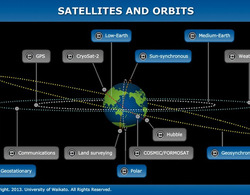A low-Earth orbit (LEO) is usually a circular orbit with an altitude from 200–2,000 km.
Advantages: requires less energy to put a satellite into LEO, less power needed to transmit data, high-resolution images
Period: about 90 minutes
Satellite examples: International Space Station
Landsat 7, CryoSat-2, COSMIC/FORMOSAT-3
Transcript
Dr Allan McInnes
What is a low-Earth orbit? An orbit that’s low near the Earth, so we usually think of a low-Earth orbit as starting around about 200 kilometres in altitude and extending up to about 2,000 kilometres.
What speed do things move at in low-Earth orbit? It varies depending on how high you are. That’s the thing with orbits – the lower you are, the faster you tend to be going but fast enough that you’ll circle the Earth once every 90 minutes or so.
We use low-Earth orbiting satellites for a wide range of things. A lot of science missions tend to be down in those kind of orbits. Low-Earth orbits have the advantage that you get to see a lot of the Earth, but you get to see it up close. So you’re circling the Earth, you only see a small piece at a time but you are very close to it. That’s great for science – you can get a lot of detail.


